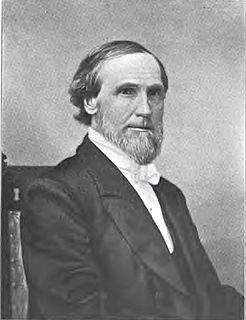
Isaac William Wiley was an American who distinguished himself as a physician, a Methodist missionary to China, a pastor, as the president of a seminary, as an editor, and as a bishop of the Methodist Episcopal Church, elected in 1872.
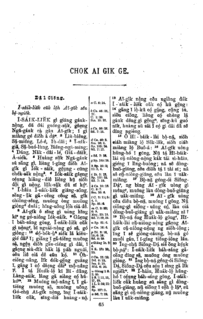
Foochow Romanized, also known as Bàng-uâ-cê or Hók-ciŭ-uâ Lò̤-mā-cê, is a Latin alphabet for the Fuzhou dialect of Eastern Min adopted in the middle of the 19th century by Western missionaries. It had varied at different times, and became standardized in the 1890s. Foochow Romanized was mainly used inside of church circles, and was taught in some mission schools in Fuzhou. However, unlike its counterpart Pe̍h-ōe-jī for Hokkien, even in its prime days Foochow Romanized was by no means universally understood by Christians.
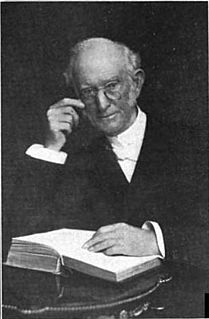
Robert Samuel Maclay, D.D. was an American missionary who made pioneer contributions to the Methodist Episcopal missions in China, Japan and Korea. He served as the first president of Aoyama Gakuin University.
Medical missions in China by Protestant and Catholic physicians and surgeons of the 19th and early 20th centuries laid many foundations for modern medicine in China. Western medical missionaries established the first modern clinics and hospitals, provided the first training for nurses, and opened the first medical schools in China. Work was also done in opposition to the abuse of opium. Medical treatment and care came to many Chinese who were addicted, and eventually public and official opinion was influenced in favor of bringing an end to the destructive trade. By 1901, China was the most popular destination for medical missionaries. The 150 foreign physicians operated 128 hospitals and 245 dispensaries, treating 1.7 million patients. In 1894, male medical missionaries comprised 14 percent of all missionaries; women doctors were four percent. Modern medical education in China started in the early 20th century at hospitals run by international missionaries.

Fuzhou people, also known as, Foochowese, Hokchew, Hokchia, Hokchiu, Fuzhou Shiyi people (福州十邑人), Eastern Min or Mindong refer to Chinese who originate from the Fuzhou and Mindong regions and the Gutian and Pingnan counties of Fujian province and Matsu Islands in Taiwan. Fuzhou people are a part of the Min Chinese-speaking group that speaks Eastern Min or specifically Fuzhou dialect. There is also a significant overseas Fuzhou population, particularly distributed in Malaysia, Indonesia, Japan, United States, Singapore and the United Kingdom.

Nathan Sites was a 19th-century Methodist Episcopal missionary who served in Foochow and Yen-ping, Fujian Province, China.

Flower Lane Church is a Christian church in Fuzhou, China.

George Carleton Lacy was an American Methodist missionary and the last Methodist Bishop in Mainland China.
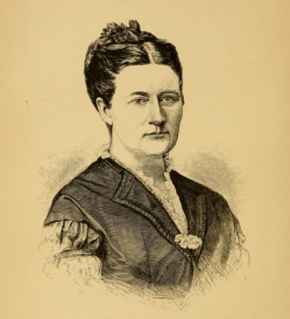
Dr. Clara A. Swain was a physician and missionary of the Methodist Episcopal Church. She has been called the "pioneer woman physician in India," and as well as the "first fully accredited woman physician ever sent out by any missionary society into any part of the Non-Christian world". Her call to service in India fell from a need to have a female physician provide quality medical care to high-caste women, that were religiously secluded to zenana. Supported by the Women's Foreign Missionary Society of the Methodist Episcopal Church, Swain left the United States in 1869, for Bareilly, India, where she spent the next twenty-seven years of her life treating women and children from illnesses, while simultaneously working to evangelize natives.

Mary Stone, also known as Shi Meiyu, was a doctor of medicine graduated from the University of Michigan. She founded the Women and Children's Hospital in Kiukiang.

Lucy Webb Hayes National Training School was a religious training school, now a hospital, in Washington, D.C. So named in memory of Lucy Webb Hayes, the wife of former President Rutherford B. Hayes. It was founded in 1891 and was the authorized training school of the Woman's Home Missionary Society of the Methodist Episcopal Church, which owned the property of the school, exercised supervision and jurisdiction over its management, and looked to it to supply the trained workers employed by the society in its widely diversified fields of labor. The privileges of the school were not, however, confined to those connected with the Woman's Home Missionary Society. It opened its doors to all who wanted to prepare themselves for any department of Christian activity. In 1894, the school was chartered by act of Congress in conjunction with the Deaconess Home and Sibley Memorial Hospital, and formed with them one corporation. The unified administration and guaranteed the training of Christian workers.
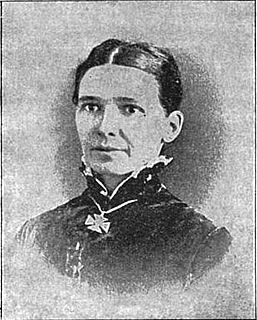
Sigourney Trask was an American physician and missionary. She is remembered as being the first woman physician at Foochow, China sent by the Methodist Episcopal Church missionaries.

Hü King Eng was a physician, and the second ethnic Chinese woman to attend university in the United States, after King You Mé.. Her medical career is well-documented, as she was treated as a celebrity by American media, due to the lack of even American women studying medicine at the time.

Woman's Foreign Missionary Society of the Methodist Episcopal Church in America was a 19th-century Protestant woman's missionary organization. It was founded in the Tremont Street Methodist Episcopal Church, in Boston, Massachusetts, March 1869. The society was incorporated under the laws of the State of New York in 1884.

The Bethel Mission in Shanghai was an independent evangelistic institution established by Shi Meiyu, Phebe Stone, and Jennie V. Hughes in 1920. It would eventually include primary and secondary schools, a hospital and nursing school, an orphanage, and, through a revival led by Paget Wilkes in 1925, the Bethel Bible School.
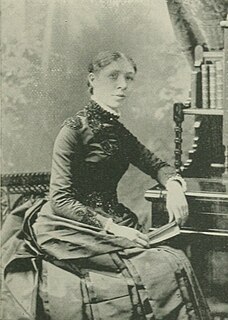
Esther E. Baldwin, known as "Chinese Champion", was an American missionary, teacher, translator, writer, and editor. She understood the religious and political problems of China, and the Chinese people, as perhaps no other woman in this country did at that time. She labored constantly to bring about a better understanding between the two nations. Baldwin was courageous in her advocacy of whatever appeared to her to be true, by whomsoever it might chance to be condemned or approved. She served as president of the New York Woman's Missionary Society for two decades.
Beulah Woolston was a pioneering American missionary teacher in China. With her sister, she founded schools, translated textbooks, and edited a Chinese-language newspaper.
Lucinda L. Combs-Stritmatter was an American physician who was the first female medical missionary to provide medical care in China and is credited with establishing the first women's hospital in what was then Peking. Combs was a pioneer in women's medical care while serving the Women's Foreign Ministry Society's North China Mission for seven years.
Phebe Stone was a physician and medical missionary who worked in Kiukiang (Jiujiang), China. She was the younger sister of the notable missionary Mary Stone, also known as Shi Meiyu. Her family was from the Hubei province in China and were one of a handful of Christians in the area. Stone went on to Goucher College in the United States for her undergraduate degree and later was awarded a fellowship to attend Johns Hopkins, where she received medical degree in 1918. Stone was the first Chinese woman to graduate from Johns Hopkins School of Medicine. Afterward, Stone briefly worked as a medical intern at a women's hospital in Worcester, Massachusetts, then returned to her hometown of Jiujiang to take over the Danforth Hospital established by her sister Mary. She later founded the Bethel Mission and its encompassing hospital in 1920 along with Mary and the American missionary Jennie Hughes. She contracted tuberculosis and died in 1930.














